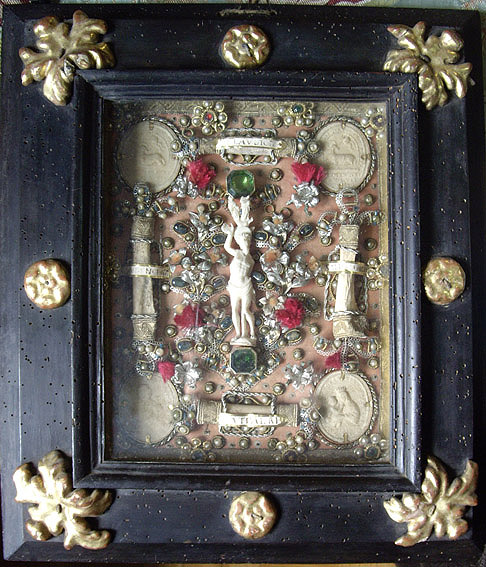The piece of the month of May 2007
RELIQUARY PICTURE
Pilar Andueza Unanua
Chair of Navarrese Heritage and Art
This piece, belonging to the convent of the Augustinian Recollect Mothers of Pamplona, is a magnificent exponent of the religiosity, faith and devotions that characterized the society of the Ancient Regime. It is a rectangular reliquary picture with black wood framework and carved appliqués with vegetal decoration and golden polychrome (40,5 x x cms.). Its interior, on salmon-colored silk, contains in the center a small ivory sculpture of St. Sebastian, around which, framing it, are the vestiges of four saints: St. Prudentius, St. Vital, St. Claudius and St. Margaret. Their bones, decorated at their ends with trimmings, sequins and metallic threads, are identified, as usual in this subject of pieces, thanks to the handwritten vellums in capital letters in black ink. This reliquary picture completes its composition, perfectly symmetrical, with four Agnus Dei located in the corners, of which it is worth mentioning their perfect state of preservation. A decoration made with a mixed technique and materials based on aljofares, metallic threads and flowers, trimmings, gallons and colored crystals is profusely and abundantly distributed, flooding practically the entire background, whose perimeter is framed by a golden gallon.
The Agnus Dei is an oval-shaped medallion made of white wax, originally from the paschal candle, mixed with the holy oils and holy water, which the Popes issued in Rome from Antiquity until almost the twentieth century. Cast since the XVII century in two-sided molds -formerly only on one side-, their obverse always shows a relief of the Lamb of God, either lying or standing, with cross and standard on the book of the Seven Seals. The image is always surrounded by a registration that reads: Ecce Agnus Dei qui tolli pecata mundi, as well as the name of the Pope who consecrated it, accompanied by the year in which it was made, the chronology of his pontificate and his heraldic emblem. On the reverse is the image of a saint or some Marian devotion. In the case we are dealing with, the two copies in the upper part show the obverse, with the name of Pope Clement VII, while the two located in the lower corners show the image of the Virgin and Child, as they are the reverse.
Their condition of consecrated object made the Agnus Dei very precious and coveted pieces among the Christian faithful, given their protective character against evils that could affect the soul, the body or their homes. Their value was such that they were even counterfeited and traded illicitly, as attested by the excommunication provisions promulgated by several pontiffs.

Reliquary box. Set
For its part, the devotion of Christians to the saints and consequently to their relics has its roots in the beginnings of Christianity. However, the Council of Trent and its decree on images and relics of saints, issued in response to the repudiation of them by Protestants, gave strong support to their invocation and veneration throughout the Catholic world. The relics thus became highly prized elements, so that the faithful aspired to their possession and possession, status that was accentuated, more if possible, thanks to the marvelous mentality of the Baroque. Therefore, in addition to the relics kept by parishes, churches, cathedrals and convents, there were also relics for private use. On some occasions the relics were introduced in small receptacles that, endowed with a ring and decorated in a diverse and careful way, allowed them to be carried hanging, becoming also devotional jewels. But to this typology were added examples such as this piece: reliquary panels that, framed, were destined for the oratories and alcoves of private homes and convents, usually cloistered. Both with the reliquary medallions and with these reliquary panels, their owners sought divine protection by entrusting themselves to the respective saint. In this case the protective character of this piece would be triple thanks to the image of Saint Sebastian, the relics of the four saints mentioned and the four Agnus Dei.

Reliquary box. Detail
Given the characteristics of the piece, this reliquary painting must have been made by the nuns of the convent who, experts in the so-called "work of nuns", would have executed it giving unity and enhancement to the most outstanding devotional pieces of the set (sculpture of San Sebastian, vestigia and Agnus Dei). Probably these last objects would have been given as gifts by some of the numerous benefactors of this monastery, among them families such as the Bernedo, Azpíroz, Lizarazu, Ibero, Elordi, Solchaga, Olagüe and many others, some of whom had members in high positions in the Church and even in Rome.
We must place the chronology of this reliquary painting at the beginning of the 18th century, as indicated by the stylistic characteristics of framework, a date that is also supported by the chronology of the Agnus Dei, which were molded in the seventh year of the pontificate of Clement XI (1700-1721), that is, in 1707.
bibliography:
AYAPE, Eugenio, Monastery of Augustinian Recollect Nuns of Pamplona. Apuntes para su historia, Recollectio, 5, 1982, pp. 189-291.
SÁENZ RUIZ DE OLALDE, José Luis, Monasterio de Agustinas Recoletas de Pamplona. Three centuries of history, Government of Navarra, 2004.
Sanctuaries of the intimate. Miniature portraits and reliquaries. La colección del Museo Soumaya, Mexico, Telmex-Museo Soumaya, 2004.
